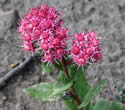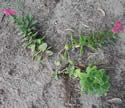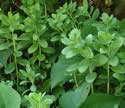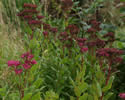Hylotelephium telephium (Orpine)
| Also known as: | Live-forever, Witch's Moneybags |
|---|---|
| Genus: | Hylotelephium |
| Family: | Crassulaceae (Stonecrop) |
| Life cycle: | perennial |
| Origin: | Europe, Asia |
| Status: |
|
| Habitat: | part shade, sun; disturbed soil; roadsides, old fields, waste places, ditches, gardens, swamp margins, woodland edges |
| Bloom season: | July - September |
| Plant height: | 8 to 36 inches |
| Wetland Indicator Status: | none |
| MN county distribution (click map to enlarge): |  |
| National distribution (click map to enlarge): |  |
Pick an image for a larger view. See the glossary for icon descriptions.
Detailed Information
Flower: 


![[photo of flowers]](/udata/r9ndp23q/pd/hylotelephium-telephium-082118-3-t.jpg) Dense, flat-topped to convex branching clusters of short-stalked flowers at the top of the stem and arising from upper leaf axils. Flowers are star-shaped, up to about 3/8 inch across with 5 spreading to recurved petals. In the center are 5 teardrop-shaped carpels surrounded by 10 pinkish stamens about as long as the petals. Color ranges from pink to purplish-red, sometimes white or greenish.
Dense, flat-topped to convex branching clusters of short-stalked flowers at the top of the stem and arising from upper leaf axils. Flowers are star-shaped, up to about 3/8 inch across with 5 spreading to recurved petals. In the center are 5 teardrop-shaped carpels surrounded by 10 pinkish stamens about as long as the petals. Color ranges from pink to purplish-red, sometimes white or greenish.
Leaves and stems: 


![[photo of leaves]](/udata/r9ndp23q/pd/hylotelephium-telephium-060518-2-t.jpg) Leaves are succulent, alternate or opposite, 1½ to 4 inches long, oblong-elliptic, coarsely serrated with small rounded teeth, hairless, rounded at the tip, rounded to wedge-shaped at the base, and stalkless. Stems are hairless, single or multiple from the base, usually unbranched, green to red-tinged, mostly ascending to erect. Plants form colonies from white, carrot-shaped tubers which form buds that can easily break off and take root.
Leaves are succulent, alternate or opposite, 1½ to 4 inches long, oblong-elliptic, coarsely serrated with small rounded teeth, hairless, rounded at the tip, rounded to wedge-shaped at the base, and stalkless. Stems are hairless, single or multiple from the base, usually unbranched, green to red-tinged, mostly ascending to erect. Plants form colonies from white, carrot-shaped tubers which form buds that can easily break off and take root.
Fruit: 
The carpels may become capsules containing many seeds, but fruit is rarely formed.
Notes:
Orpine, formerly Sedum telephium or Sedum purpureum, is a hardy garden species that can escape cultivation and is more widespread in the northeastern US into Canada. In Minnesota, it is occasionally encountered along roadsides and other areas with disturbed soils and was first recorded in Rock County in 1890. It is drought and salt tolerant and there are numerous cultivars in the garden trade of varying flower and foliage colors (even purple).
Orpine is typically recognized by its tight clusters of pink to purple-red star-shaped flowers with 10 stamens about as long as the petals, and the succulent, oblong-elliptic leaves coarsely serrated along the edge. Stems are leafy and not usually branched, and emerge from white, carrot-shaped tubers. It resembles other Sedums, which may have larger flowers, stamens distinctly longer or shorter than the petals, fewer stamens, and/or toothless or less toothy leaves.
Of note is we have only seen vegetative populations where it has naturalized, mostly along roadsides and tree-lines. We grew it in the garden just to get flower images, then yanked it up.
Native Plant Nurseries, Restoration and Landscaping Services ↓
More photos
Photos by Peter M. Dziuk taken in St. Louis County and in his garden. Photo by Hans Dekker via Saxifraga, FreeNatureImages.eu
Comments
Have you seen this plant in Minnesota, or have any other comments about it?
on: 2020-06-10 05:58:35
I thought I saw this blooming along side the wildflower trail along the Cascade Creek in arrowhead county. It was about thirty yards down hill from where the purple wild orchids are blossoming. It appeared to be at the end of its bloom.
on: 2020-07-05 12:31:03
Orpine grows in Duluth. Found along parking lot d Lot ditches
on: 2022-07-18 18:00:22
Quite a bit of this growing along the roadway into where Tettegouche camp is. First time seeing this plant and it is still growing so not 100% sure.







 Orpine plant
Orpine plant Orpine plants
Orpine plants spreading vegetatively
spreading vegetatively Orpine plants ©Hans Dekker
Orpine plants ©Hans Dekker